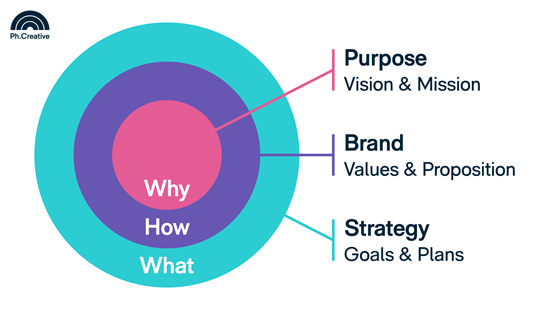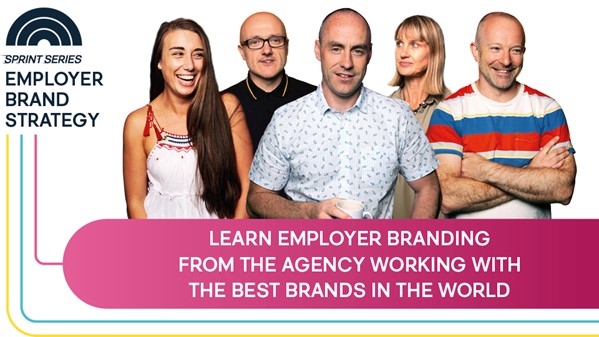From Why to What: Designing Your Employer Brand for Impact
3 min read.
Many of you will be familiar with Simon Sinek and his renowned “Start with Why” video – it is still one of the most watched TedTalk’s of all time - but for those that aren't, Sinek is an author and motivational speaker dedicated to changing the way we think about leadership.
Famed for his “golden circle” framework, Sinek believes that a pattern lies behind the success of every great venture, from the creation of Apple to the Wright Brothers’ first aircraft, and it’s the complete opposite to what everyone else is doing.

Sinek argues that by starting with “why” (the purpose or greater meaning behind a company) and working outwards to the “how” and the “what”, you can inspire your employees, an ability he deems extremely important.
“The organisations and leaders with the ability to inspire us come in all shapes and sizes," he says."Regardless of where they exist, they have a disproportionate amount of influence in their industries. They have the most loyal customers and the most loyal employees. They tend to be more profitable than others in their industry. They are more innovative, and most importantly, they are able to sustain all these things over the long term. Many of them change industries. Some of them even change the world.”
Employer branding has a lot to do with inspiration. Inspiring action from candidates, inspiring advocacy from employees and telling moving, authentic stories.
So let’s break down exactly how to apply this framework to design an effective and inspiring employer brand.
The Why:
This is your business’s reason for being, your purpose that goes beyond turning a profit.
For example, at Ph. Creative, we call our team the “Defenders of Happiness” because our vision is to enrich as many lives as possible, by helping people to love their work. Tight-knit teams, workers feeling challenged, inspired, and motivated, that’s what makes the juice worth the squeeze; that’s our why.
And there's a good reason to have a defined one.
Data shows that employees who feel connected to a sense of collective purpose are much more likely to find their work fulfilling.
That said, a shared vision is not enough on its own to win more than your fair share of top talent.
A recent McKinsey study revealed that nearly 70% of professionals considered work a key component of defining their own purpose, so don't overlook the importance of uncovering the personal purpose of your workforce.
That’s where the “how” comes in.
The How:
No one knows your organisation better than the people who work in it every single day.
The “how” in employer branding is all about digging out the motivators, drivers, priorities, values, behaviours and preferences of these people. What do they appreciate in life?
Discover this, and you will gain a holistic understanding of how employees at all levels of the business view the company experience.
From there you can figure out how to communicate this to your audience. Why should (or shouldn’t) they work for you? This is where your proposition comes in.
Consider:
- What does your company offer an employee, in terms of challenges and rewards?
- What must they be willing to give, to excel and reap the benefits available to them?
- What does it take to not simply work, but thrive in your organisation?
This is what we all crave, after all. The chance to feel uniquely suited for something significant, to belong.
Sinek says: “The goal is not to do business with everybody that needs what you have. The goal is to do business with people who believe what you believe. The goal is not just to hire people who need a job, it’s to hire people who believe what you believe.”
And he’s right, but here’s the addendum: It’s not good enough to hire someone who simply believes in your mission if they do not also subscribe to your core values.
To use Ph. as an example, it is no good if a candidate believes in defending happiness at work but lacks problem solving skills, self-motivation and the ability to work under pressure that we need from an employee.
If they don’t share your values, they simply will not thrive in your company environment.
A shared vision is good; shared values are better.
The What
It's a challenge every employer brand leader faces: what can I do to prove that x storytelling social posts had y impact on time to fill?
This ring of the circle is where you focus on the way you will track and prove the impact of your employer brand.
It is where you decide your short-term and long-term goals, the most important measurements to take notice of for your business and the things you need to see an improvement in to satisfy key stakeholders.
What kind of shared language will you use to communicate to talent? What metrics will you focus on? What changes will you make to your careers site and social media posts? What do you hope to gain for your talent priorities?
In employer branding, execution is everything. So, a clear strategy is essential for making an impact.
To sum up
A purpose-led company is an attractive thing to have, but it's not a magic bullet for drawing in great talent. You need the other pieces of the puzzle.
Having a strong sense of each ring of the golden circle, the “why”, “how” and “what” of your organisation and drawing on the personal purpose of your workforce will ensure that your brand is both compelling and impactful in the areas you need it to be, putting you head and shoulders above the competition.
Need a helping hand with your Employer Brand strategy? Our experts have road tested strategies with a world-class client list to bring you the very best tools and frameworks in this flexible, three week course.
